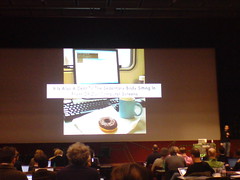LIFT07: What happens when 1st life meets 2nd life, Julian Bleecker
LIFT07: What happens when 1st life meets 2nd life, Julian Bleecker
 2nd life worlds are made out of bits, which are supported by hardware atoms (no, really), customer support resources, energy. According to Nicolas Carr, an avatar uses 1752kwh/year of energy. A real person, 2436kwh. We're not thinking that coal is being burned to support these.
2nd life worlds are made out of bits, which are supported by hardware atoms (no, really), customer support resources, energy. According to Nicolas Carr, an avatar uses 1752kwh/year of energy. A real person, 2436kwh. We're not thinking that coal is being burned to support these.
There's also a debt to our bodies: obesity from a sedentary lifestyle, etc. (Not that in days of Wii, this is necessarily the case). Real people die.
How to bridge the two? Make 2nd life worlds remind us of the material contingencies of the real world (I'd argue that escapism is part of the point of them)?
Start by bringing back motion, time and distance into 2nd life?
Examples:
- Wii overlays physical controller.
- Animal Crossing is extremely time-based: day/night, seasonal variations, appointments to carry out actions at certain times, etc.
- Teku Teku Angel: tamagotchi attached to a pedometer: distance is a part of the game, you feel exertion;
Not sure I follow the argument here. TV uses more electricity than radio. Does this mean we should explore ways to make TV more radio-like?
Q: How should NGOs etc using Second Life best recognise their impact?
Q: There's been some research on Second Life as a place in which one projects ones consciousness, e.g. patients in burns units undergoing a virtual "snow" experience which reduces pain levels.
(Is this real? I can't find any reference online)
Q: If a user expends